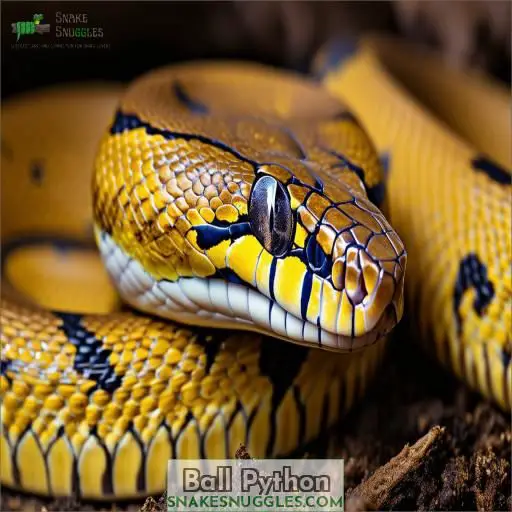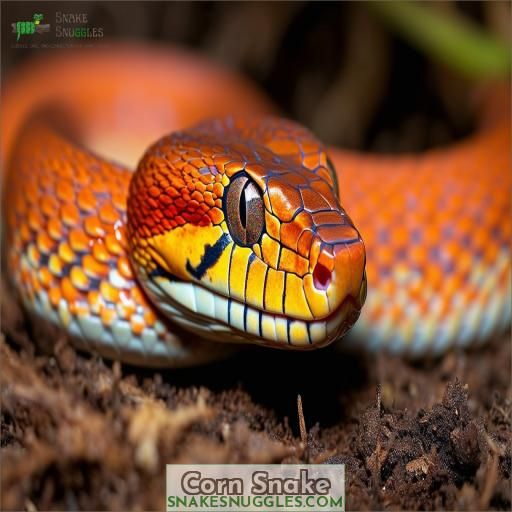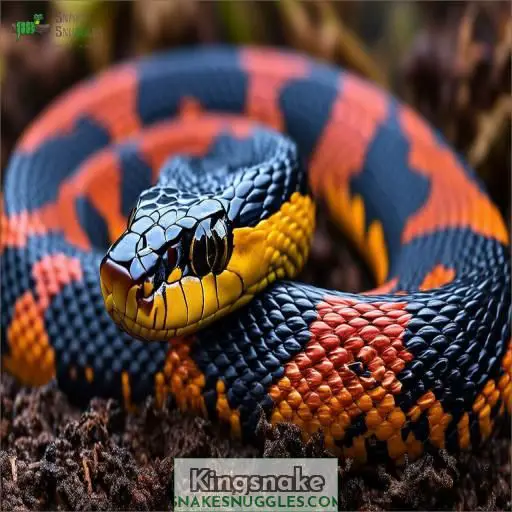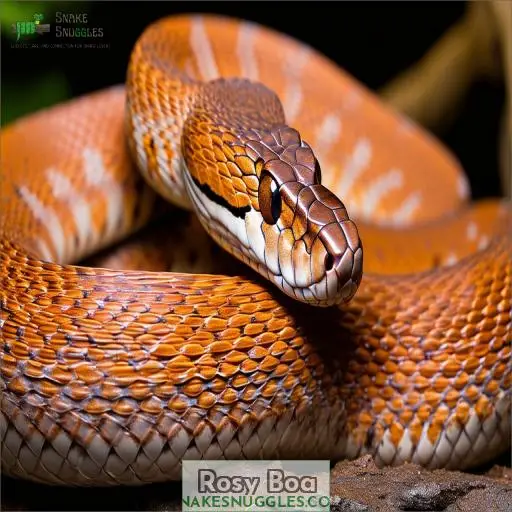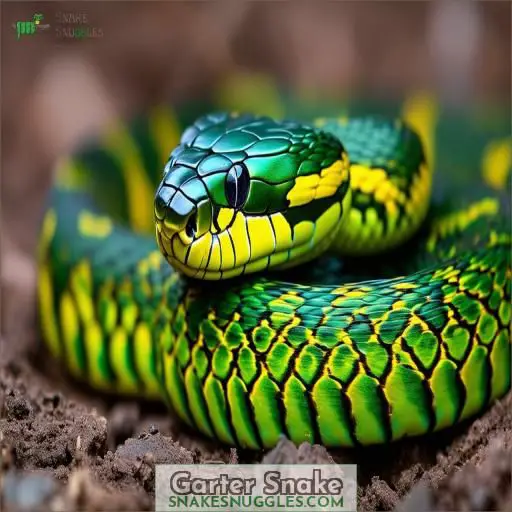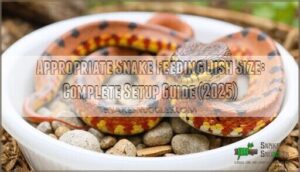This site is supported by our readers. We may earn a commission, at no cost to you, if you purchase through links.
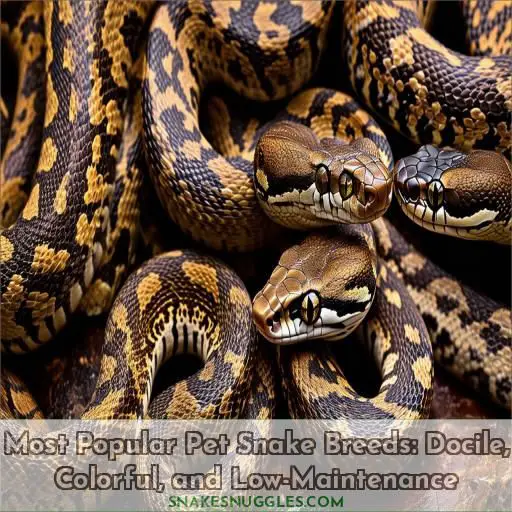 If you’re considering a slithery companion, the most popular pet snake breeds will charm you with their docile nature and alluring hues.
If you’re considering a slithery companion, the most popular pet snake breeds will charm you with their docile nature and alluring hues.
The ball python, with its placid temperament and array of color morphs, makes an ideal starter snake.
Corn snakes, known for their calm demeanor and striking patterns, are another beginner-friendly option.
Kingsnakes, though moderate in size, are docile and non-aggressive.
The gentle rosy boa, tolerant of handling, is a low-maintenance gem.
And if you seek an active presence, garter snakes are sure to delight with their diurnal antics.
Dive deeper, and you’ll uncover why these charming reptiles have slithered their way into countless hearts.
Table Of Contents
- Key Takeaways
- Ball Python
- Corn Snake
- Kingsnake
- Rosy Boa
- Garter Snake
- Frequently Asked Questions (FAQs)
- What is the most popular snake to have as a pet?
- What is the best beginner snake?
- What is the most common type of snake?
- What is the hardest pet snake to take care of?
- How often should pet snakes be fed?
- Are there any legal restrictions on owning snakes?
- What are the signs of a sick snake?
- How do you safely introduce a new snake?
- Can pet snakes be trained to respond to commands?
- Conclusion
Key Takeaways
- Brace yourself for an adventure! From the gentle ball python to the vibrant corn snake, these slithery friends come in all shapes, colors, and temperaments to charm their way into your heart.
- Don’t let their scaly exteriors fool you – many popular pet snakes are delightfully docile and low-maintenance companions. With the right care, they make lifelong buddies you can cuddle (yes, cuddle!) for years.
- Forget the stereotypes – these modern-day serpents like to stand out from the crowd with their dazzling designer coats. Whether you fancy a hypnotic glacier morph or a fiery candy cane pattern, there’s a slithery fashionista to suit your style.
- Size doesn’t matter when it comes to snakes – these petite personalities pack a punch! From the compact rosy boa to the playful garter snake, you’ll find the perfect fit for your household and lifestyle.
Ball Python
The ball python is a popular pet snake choice due to its docile temperament and stunning array of color morphs. With a moderate size reaching up to 6 feet and a long lifespan of up to 30 years, the ball python makes for a rewarding and visually alluring companion.
Docile Temperament
You want a friendly, hypoallergenic pet snake. Ball pythons are a beginner-friendly snake species available in various colors. Their docile temperament makes them easily handleable, especially for children. As a pet snake, ball pythons are a variety of docile and child-friendly snake.
Variety of Color Morphs
You’ll be amazed by ball pythons’ genetic diversity, with hundreds of captive-bred color morphs. Ethical breeders aim to conserve endangered species through safe, responsible breeding programs—giving you vibrant pet snake options while aiding conservation efforts.
Moderate Size (up to 6 Feet)
As for their moderate size, ball pythons typically reach lengths of 4-6 feet, requiring an enclosure with:
- Ample floor space
- Proper heating/lighting
- Secure lids
- Hiding spots
Their size makes them suitable for many households, provided their environmental needs are met through proper habitat setup.
Long Lifespan (up to 30 Years)
With their longevity potential of up to 30 years in captivity, ball pythons are a long-term commitment as snake pets. You’ll need to maintain proper diet and habitat conditions to support their aging process and maximize their lifespan expectations. Their extended age range means these docile beauties can be rewarding, lifelong companions with responsible care.
Corn Snake
The corn snake is an ideal starter pet snake due to its generally calm temperament and tolerance for handling. These snakes display beautiful patterns and colors ranging from bright oranges and reds to subdued browns and grays, complementing their small to medium adult size of up to 5 feet long and lifespan reaching up to 20 years with proper care.
Calm and Easy to Handle
As for the corn snake, you’re in for a treat – these slithery companions are an epitome of calmness, making them an ideal snake for beginners. Here’s why corn snakes deserve a spot in your heart (and home):
- Docile nature, perfect for first-time snake owners
- Rarely bite or get defensive when handled properly
- Tolerate regular handling and interaction
- Easily tamed, quickly adapting to their new environment
- Low-maintenance, making corn snakes a joy to care for
Beautiful Color Patterns
| You’ll find corn snakes come in a dazzling array of | Pattern | Color |
|---|---|---|
| Candy Cane Stripes | Red, White, Black | |
| Glacier Marble | White, Gray, Black | |
| Hypomelanistic | Rusty Red, Burnt Orange |
Their color variety and pattern diversity captivate with aesthetic appeal.
Small to Medium Size (up to 5 Feet)
At an adult size of 3-5 feet, corn snakes are perfectly-sized pets for most households. Their compact length allows for reasonably-sized enclosures, while still offering an impressive serpentine presence. Whether a vivid Okeetee or vibrant Candy Cane morph, these snakes combine manageable proportions with eye-catching patterns.
Long Lifespan (up to 20 Years)
With lifespans up to 20 years, corn snakes are a long-lasting pet option. You’ll form a lasting bond as you provide proper:
- Enclosure with appropriate heating/lighting
- Diet of appropriately sized rodents
- Enrichment for mental stimulation
Their longevity rewards committed owners with years of scaly companionship.
Kingsnake
Kingsnakes, a broad group encompassing various species and subspecies, make exceptional pets due to their generally docile and non-aggressive nature. Despite their moderate size, reaching up to 5 feet in length, these snakes possess the remarkable ability to consume other snakes in the wild.
Variety of Species and Subspecies
There are many kingsnake species and subspecies to choose from, like sand boas, pueblan milksnakes, gopher snakes, children’s pythons, and milk snakes. Each has unique care needs – proper snake water dishes, hygrometers, and decor are essential.
Docile and Non-aggressive
You’ll find kingsnakes to be docile and non-aggressive, making them excellent beginner snakes. These traits stem from:
- Lack of venom
- Gentle nature
- Tolerance of handling
- Rarely bite when threatened
- Adapt well to captivity
Moderate Size (up to 4.5 Feet)
If you’re seeking a moderate-sized pet snake, kingsnakes (up to 4.5 feet) make an excellent choice. Their manageable size allows for appropriate housing and handling. With proper care, these fascinating reptiles can thrive in terrariums, showcasing their beautiful patterns. Experienced keepers appreciate their generally calm dispositions and reasonable maintenance requirements.
Eat Other Snakes in the Wild
You may find kingsnakes’ wild tendencies fascinating – their territoriality drives them to hunt and consume other snakes. Inter-species aggression stems from competition for resources like food and shelter. Understanding snake cannibalism’s causes, like overlapping habitats and predatory instincts, enhances your appreciation for their primal nature.
Rosy Boa
The rosy boa is a gentle and docile snake that makes an excellent pet for beginners. With a maximum length of around 3 feet and a lifespan up to 15 years, these small boas have a calm temperament, tolerate regular handling well, and exhibit interesting burrowing behaviors.
Gentle and Tolerant of Handling
You’ll love rosy boas‘ gentle nature – they tolerate handling well. However, account for size differences, dietary needs, enclosure requirements, temperament variations, and shedding habits to care for these mellow pets properly.
Small Size (up to 3 Feet)
You’ll adore the rosy boa’s compact size – up to 3 feet! Its:
- Small frame fits snugly in your hands
- Petite stature makes housing a breeze
- Diminutive body belies its gentle nature
Just imagine cradling this cuddly python-esque snake! With proper care, it’ll become your cherished, low-maintenance companion.
Long Lifespan (up to 15 Years)
You’ll enjoy your rosy boa’s company for over a decade, as they can live up to 15 years! Compare that to:
| Snake | Lifespan |
|---|---|
| Gopher | 20 Years |
| Milk | 20 Years |
| Corn | 20 Years |
| Python | 30 Years |
Their enduring nature is just one reason they shine as pets.
Burrowing Behavior
Rosy boas’ burrowing habits demand proper substrate and enclosure depth. Provide:
- Loose substrate (e.g., cypress mulch) for digging
- Humid hideout (e.g., moss-filled box) for refuge
- Deep enclosure (≥12 inches) to mimic natural burrows
Their burrowing instincts fulfill behavioral needs, ensuring your rosy boa thrives.
Garter Snake
Garter snakes, with their small size (up to 4 feet) and active diurnal nature, make excellent pets for those seeking a lively and interactive snake species. These snakes come in a variety of vibrant color patterns and subspecies, and are commonly found in the wild across North America, making them a readily available and popular choice among reptile enthusiasts.
Small Size (up to 4 Feet)
You’ll love garter snakes’ small size – they max out at 4 feet! Perfect for beginners. Check out this size comparison:
| Snake | Length |
|---|---|
| Children’s Python | 2-4 feet |
| Gopher Snake | 3-6 feet |
| Garter Snake | 2-4 feet |
Small snakes mean easier handling and cheaper habitats.
Active and Diurnal
While garter snakes are diurnal, actively hunting during the day, they still require basking sites to thermoregulate. Understanding their diurnal behavior and selecting an enclosure mimicking their preferred microhabitats are essential for proper care.
Variety of Color Patterns
Along with their active nature, garter snakes exhibit a stunning variety of color patterns. This genetic diversity results from breeding morphs to produce alluring combinations, reflecting their diverse habitats. Proper captive care appreciates these incredible pattern variations, allowing for healthy expression.
Commonly Found in the Wild
You’ve likely encountered garter snakes in the wild. Their diverse wild habitats span:
- Woodlands and forests
- Grassy meadows and prairies
- Wetlands and suburban areas
- Various North American regions
Conserving these non-venomous, ecologically critical snakes is essential for balanced ecosystems.
Frequently Asked Questions (FAQs)
What is the most popular snake to have as a pet?
The most popular pet snake is the corn snake. It’s docile, easy to care for, and comes in various colors and patterns, making it appealing to both beginners and experienced reptile enthusiasts.
What is the best beginner snake?
You’ll want a docile, small-to-medium sized snake like a corn snake or rosy boa. They’re calm, easy to handle, and have simple care needs—perfect for beginners getting their first pet snake.
What is the most common type of snake?
Where the slithery trails lead, you’ll find the garter snake – the most common snake species in North America. These small, active reptiles adapt well to various habitats, boasting vibrant colors and docile personalities that make them fan favorites.
What is the hardest pet snake to take care of?
The green anaconda is considered one of the most challenging pet snakes to care for. At up to 17 feet long and requiring very large enclosures with specific humidity and temperature levels, they demand an extremely high level of expertise from their owners.
How often should pet snakes be fed?
Balancing activity and rest, feed pet snakes appropriately-sized prey every 5-14 days; smaller snakes eat more frequently. Their needs vary based on age, species, temperature–freedom to thrive requires understanding their natural cues.
Are there any legal restrictions on owning snakes?
Yes, many areas have regulations on snake ownership. You’ll need permits for certain species, especially venomous or large constrictors. Verify local laws before getting a pet snake to guarantee compliance.
What are the signs of a sick snake?
Signs of a sick snake include lack of appetite, lethargy, abnormal shedding, discharge from eyes or mouth, and visible lumps or sores. Monitor your snake’s behavior closely and consult a reptile vet if you notice any concerning changes.
How do you safely introduce a new snake?
While it seems challenging, introducing a new snake is straightforward with preparation. Quarantine the new snake first to monitor health and behavior. Then, gradually introduce the snake to its new environment allowing it time to acclimate safely and stress-free.
Can pet snakes be trained to respond to commands?
You can train snakes to some degree through positive reinforcement, like offering food rewards. However, snakes have small brains and training is limited compared to mammals. Focus on building trust through gentle handling for a rewarding pet experience.
Conclusion
Are you ready to plunge into the enthralling world of the most popular pet snake breeds? From the gentle ball python to the lively garter snake, these docile, colorful, and low-maintenance reptiles offer an enchanting glimpse into the beauty of nature.
With proper care and knowledge, welcoming one of these slithery companions into your home can be a rewarding and enriching experience.

